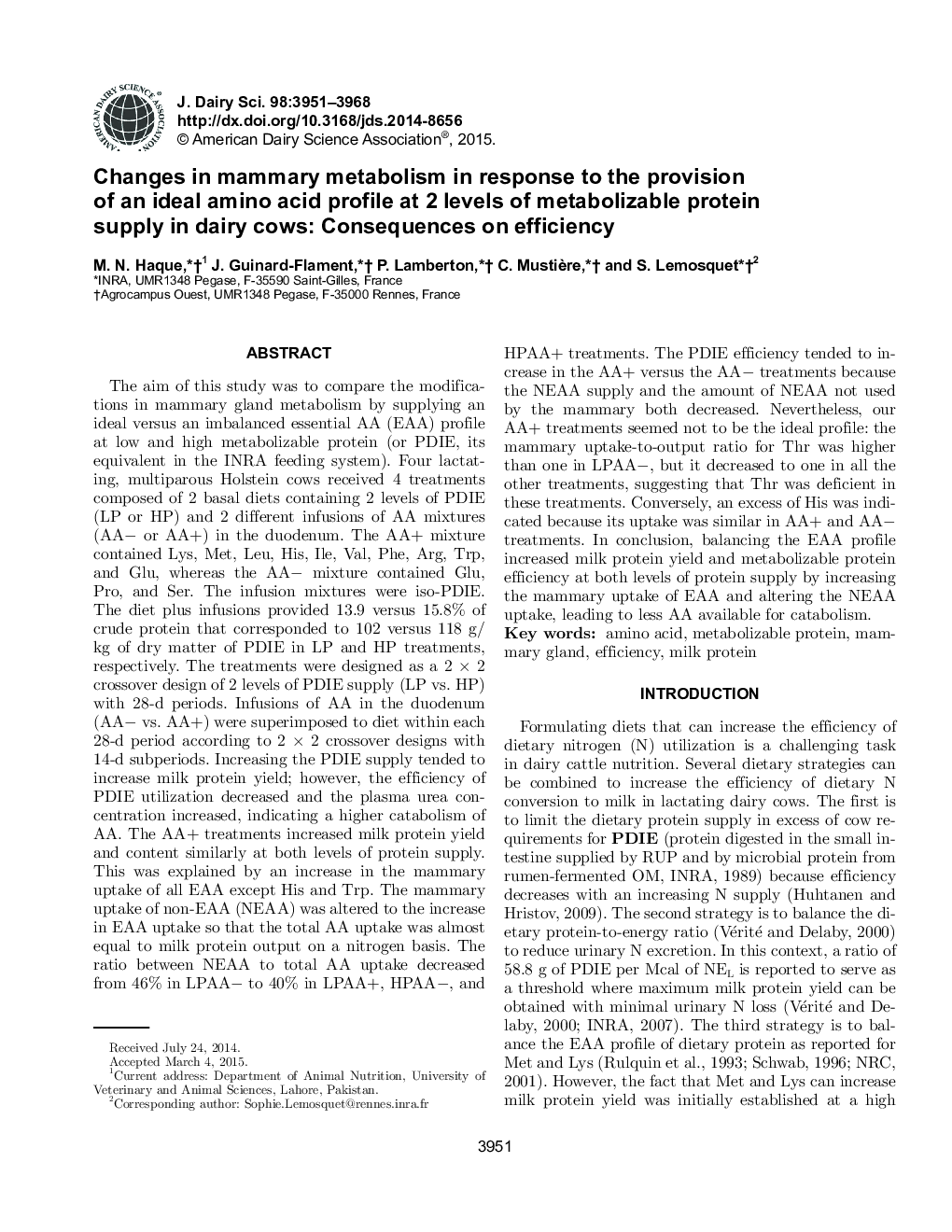| کد مقاله | کد نشریه | سال انتشار | مقاله انگلیسی | نسخه تمام متن |
|---|---|---|---|---|
| 10975809 | 1108036 | 2015 | 18 صفحه PDF | دانلود رایگان |
عنوان انگلیسی مقاله ISI
Changes in mammary metabolism in response to the provision of an ideal amino acid profile at 2 levels of metabolizable protein supply in dairy cows: Consequences on efficiency
ترجمه فارسی عنوان
تغییرات در متابولیسم پستان در پاسخ به ارائه نمایه ای اسید آمینه ایده آل در دو سطح پروتئین متابولیزه شده در گاوهای شیری: پیامدهای بهره وری
دانلود مقاله + سفارش ترجمه
دانلود مقاله ISI انگلیسی
رایگان برای ایرانیان
کلمات کلیدی
آمینو اسید، پروتئین متابولیزه کننده، غده پستانی، بهره وری، پروتئین شیر
موضوعات مرتبط
علوم زیستی و بیوفناوری
علوم کشاورزی و بیولوژیک
علوم دامی و جانورشناسی
چکیده انگلیسی
The aim of this study was to compare the modifications in mammary gland metabolism by supplying an ideal versus an imbalanced essential AA (EAA) profile at low and high metabolizable protein (or PDIE, its equivalent in the INRA feeding system). Four lactating, multiparous Holstein cows received 4 treatments composed of 2 basal diets containing 2 levels of PDIE (LP or HP) and 2 different infusions of AA mixtures (AAâ or AA+) in the duodenum. The AA+ mixture contained Lys, Met, Leu, His, Ile, Val, Phe, Arg, Trp, and Glu, whereas the AAâ mixture contained Glu, Pro, and Ser. The infusion mixtures were iso-PDIE. The diet plus infusions provided 13.9 versus 15.8% of crude protein that corresponded to 102 versus 118Â g/kg of dry matter of PDIE in LP and HP treatments, respectively. The treatments were designed as a 2Â ÃÂ 2 crossover design of 2 levels of PDIE supply (LP vs. HP) with 28-d periods. Infusions of AA in the duodenum (AAâ vs. AA+) were superimposed to diet within each 28-d period according to 2Â ÃÂ 2 crossover designs with 14-d subperiods. Increasing the PDIE supply tended to increase milk protein yield; however, the efficiency of PDIE utilization decreased and the plasma urea concentration increased, indicating a higher catabolism of AA. The AA+ treatments increased milk protein yield and content similarly at both levels of protein supply. This was explained by an increase in the mammary uptake of all EAA except His and Trp. The mammary uptake of non-EAA (NEAA) was altered to the increase in EAA uptake so that the total AA uptake was almost equal to milk protein output on a nitrogen basis. The ratio between NEAA to total AA uptake decreased from 46% in LPAAâ to 40% in LPAA+, HPAAâ, and HPAA+ treatments. The PDIE efficiency tended to increase in the AA+ versus the AAâ treatments because the NEAA supply and the amount of NEAA not used by the mammary both decreased. Nevertheless, our AA+ treatments seemed not to be the ideal profile: the mammary uptake-to-output ratio for Thr was higher than 1 in LPAAâ, but it decreased to 1 in all the other treatments, suggesting that Thr was deficient in these treatments. Conversely, an excess of His was indicated because its uptake was similar in AA+ and AAâ treatments. In conclusion, balancing the EAA profile increased milk protein yield and metabolizable protein efficiency at both levels of protein supply by increasing the mammary uptake of EAA and altering the NEAA uptake, leading to less AA available for catabolism.
ناشر
Database: Elsevier - ScienceDirect (ساینس دایرکت)
Journal: Journal of Dairy Science - Volume 98, Issue 6, June 2015, Pages 3951-3968
Journal: Journal of Dairy Science - Volume 98, Issue 6, June 2015, Pages 3951-3968
نویسندگان
M.N. Haque, J. Guinard-Flament, P. Lamberton, C. Mustière, S. Lemosquet,
